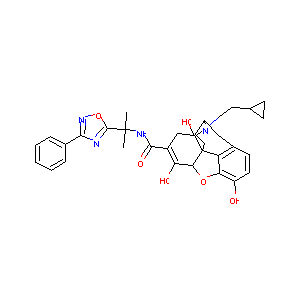Details of the Drug
General Information of Drug (ID: DM26IH8)
| Drug Name |
S-297995
|
|||||||||||||||||||
|---|---|---|---|---|---|---|---|---|---|---|---|---|---|---|---|---|---|---|---|---|
| Synonyms |
NALDEMEDINE; UNII-03KSI6WLXH; 03KSI6WLXH; S-297,995; 916072-89-4; Naldemedine [USAN:INN]; Naldemedine (USAN/INN); S 297995; SCHEMBL9880572; GTPL9150; CHEMBL2105755; AKOS032945757; DB11691; Morphinan-7-carboxamide, 17-(cyclopropylmethyl)-6,7-didehydro-4,5-epoxy-3,6,14- trihydroxy-N-(1-methyl-1-(3-phenyl-1,2,4-oxadiazol-5-yl)ethyl)-,(5alpha)-; J3.573.009E; D10188
|
|||||||||||||||||||
| Indication |
|
|||||||||||||||||||
| Drug Type |
Small molecular drug
|
|||||||||||||||||||
| Structure |
 |
|||||||||||||||||||
| 3D MOL | 2D MOL | |||||||||||||||||||
| #Ro5 Violations (Lipinski): 1 | Molecular Weight (mw) | 570.6 | ||||||||||||||||||
| Topological Polar Surface Area (xlogp) | 3.2 | |||||||||||||||||||
| Rotatable Bond Count (rotbonds) | 6 | |||||||||||||||||||
| Hydrogen Bond Donor Count (hbonddonor) | 4 | |||||||||||||||||||
| Hydrogen Bond Acceptor Count (hbondacc) | 9 | |||||||||||||||||||
| ADMET Property |
|
|||||||||||||||||||
| Chemical Identifiers |
|
|||||||||||||||||||
| Cross-matching ID | ||||||||||||||||||||
Molecular Interaction Atlas of This Drug
 Drug Therapeutic Target (DTT) |
|
||||||||||||||||||||||||||
|---|---|---|---|---|---|---|---|---|---|---|---|---|---|---|---|---|---|---|---|---|---|---|---|---|---|---|---|
| Molecular Interaction Atlas (MIA) | |||||||||||||||||||||||||||
Drug-Drug Interaction (DDI) Information of This Drug
|
Coadministration of a Drug Treating the Disease Different from S-297995 (Comorbidity)
|
||||||||||||||||||||||||||||||||||||||||||||||||||||||||||||||||||||||||||||||||||||||||||||||||||||||||||||||||||||||||||||||||||||||||||||||||||||||||||||||||||||||||||||||||||
Drug Inactive Ingredient(s) (DIG) and Formulation(s) of This Drug
References
| 1 | Clinical pipeline report, company report or official report of Shionogi (2011). | ||||
|---|---|---|---|---|---|
| 2 | FDA approval: ado-trastuzumab emtansine for the treatment of patients with HER2-positive metastatic breast cancer. Clin Cancer Res. 2014 Sep 1;20(17):4436-41. | ||||
| 3 | An FDA phase I clinical trial of quinacrine sterilization (QS). Int J Gynaecol Obstet. 2003 Oct;83 Suppl 2:S45-9. | ||||
| 4 | Methadone treatment and its dangers. Medicina (Kaunas). 2009;45(5):419-25. | ||||
| 5 | The mu1 and mu2 opioid receptor binding of ketobemidone, norketobemidone and 3-dimethylamino-1,1-diphenylbutene. Pharmacol Toxicol. 1996 Aug;79(2):103-4. | ||||
| 6 | URL: http://www.guidetopharmacology.org Nucleic Acids Res. 2015 Oct 12. pii: gkv1037. The IUPHAR/BPS Guide to PHARMACOLOGY in 2016: towards curated quantitative interactions between 1300 protein targets and 6000 ligands. (Ligand id: 7094). | ||||
| 7 | Retrospective diagnosis of an adverse drug reaction in a breastfed neonate: liquid chromatography-tandem mass spectrometry quantification of dextropropoxyphene and norpropoxyphene in newborn and maternal hair. J Anal Toxicol. 2008 Nov-Dec;39(9):787-9. | ||||
| 8 | mu-opioid receptor-stimulated synthesis of reactive oxygen species is mediated via phospholipase D2. J Neurochem. 2009 Aug;110(4):1288-96. | ||||
| 9 | An evaluation of mu-opioid receptor (OPRM1) as a predictor of naltrexone response in the treatment of alcohol dependence: results from the Combined Pharmacotherapies and Behavioral Interventions for Alcohol Dependence (COMBINE) study. Arch Gen Psychiatry. 2008 Feb;65(2):135-44. | ||||
| 10 | Comparison of the effects of dextromethorphan, dextrorphan, and levorphanol on the hypothalamo-pituitary-adrenal axis. J Pharmacol Exp Ther. 2004 May;309(2):515-22. | ||||
| 11 | Functional characterization of a sigma receptor and its gene expression by haloperidol. Nippon Yakurigaku Zasshi. 1999 Jul;114(1):61-8. | ||||
| 12 | Unconditioned behavioral effects of the powerful kappa-opioid hallucinogen salvinorin A in nonhuman primates: fast onset and entry into cerebrospin... J Pharmacol Exp Ther. 2009 Feb;328(2):588-97. | ||||
| 13 | Actions of tilidine and nortilidine on cloned opioid receptors. Eur J Pharmacol. 2005 Jan 4;506(3):205-8. | ||||
| 14 | Product Information. Symproic (naldemedine). Shionogi USA Inc, Florham Park, NJ. | ||||
| 15 | Cerner Multum, Inc. "Australian Product Information.". | ||||
| 16 | Cerner Multum, Inc. "UK Summary of Product Characteristics.". | ||||
| 17 | Product Information. Balversa (erdafitinib). Janssen Products, LP, Horsham, PA. | ||||
| 18 | Product Information. Turalio (pexidartinib). Daiichi Sankyo, Inc., Parsippany, NJ. | ||||
| 19 | Product Information. Orladeyo (berotralstat). BioCryst Pharmaceuticals Inc, Durham, NC. | ||||
| 20 | Product Information. Tabrecta (capmatinib). Novartis Pharmaceuticals, East Hanover, NJ. | ||||
| 21 | Product Information. Reyvow (lasmiditan). Lilly, Eli and Company, Indianapolis, IN. | ||||
| 22 | EMA. European Medicines Agency. European Union "EMA - List of medicines under additional monitoring.". | ||||
| 23 | Product Information. Xeglyze (abametapir topical). Dr. Reddy's Laboratories Inc, Upper Saddle River, NJ. | ||||
| 24 | Product Information. Xenleta (lefamulin). Nabriva Therapeutics US, Inc., King of Prussia, PA. | ||||
| 25 | Product Information. Tavalisse (fostamatinib). Rigel Pharmaceuticals, South San Francisco, CA. | ||||
